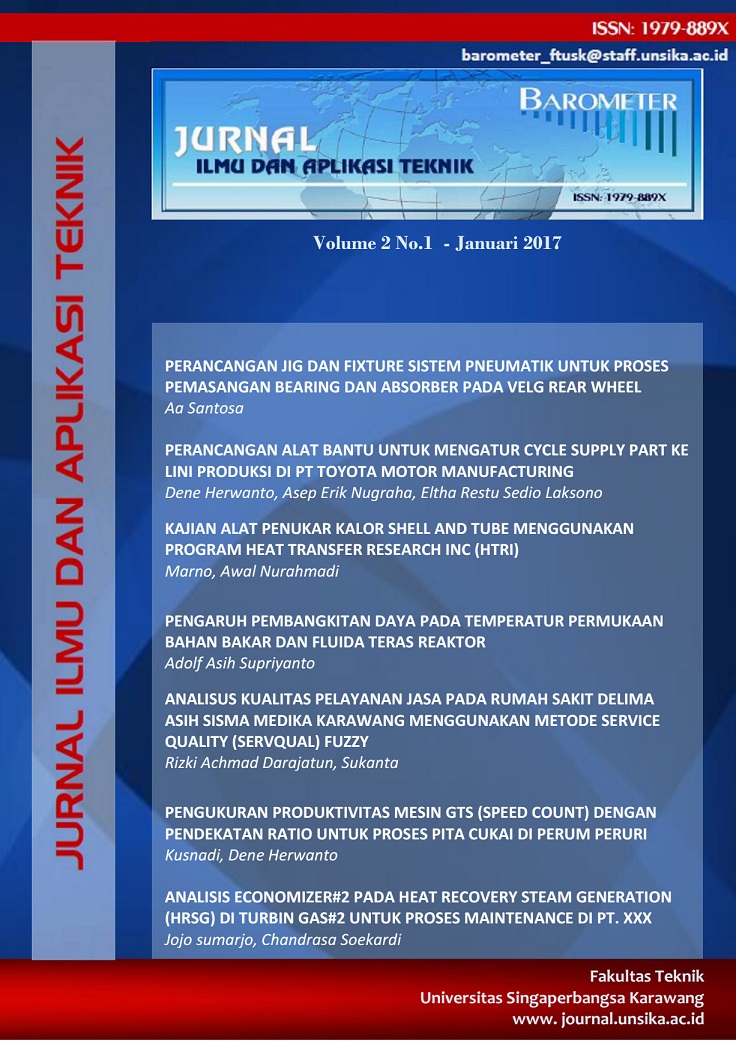ANALISIS KUALITAS PELAYANAN JASA PADA RUMAH SAKIT DELIMA ASIH SISMA MEDIKA KARAWANG MENGGUNAKAN METODE SERVICE QUALITY (SERVQUAL) FUZZY
DOI:
https://doi.org/10.35261/barometer.v2i1.599Abstrak
Tingkat kualitas pelayanan merupakan parameter keberhasilan jasa yang diberikan kepada konsumen. Penelitian ini dilakukan di Rumah Sakit Umum – Instalansi Rawat Inap Kelas III dengan responden sebanyak 40 orang. Metode servqual diterapkan dengan pendekatan fuzzy terhadap lima dimensi kualitas jasa berupa tangible, reliability, responsiveness, assurance, dan emphaty. Hasil penelitian menunjukkan bahwa adanya gap antara persepsi pasien dengan harapan pasien sebesar -0,511. Prioritas pelayanan pelayanan adalah dimensi kualitas reliability karena memiliki nilai gap terbesar yaitu -0,657. Lima faktor jasa yang paling berpengaruh atas ketidakpuasan pasien di lokasi tersebut yaitu pelayanan pemeriksaan, pengobatan dan perawatan cepat dan tepat; luas area dan fasilitas kamar; kesiapan dokter dan perawat melayani pasien setiap saat; perawat selalu mengingatkan keamanan dalam menyimpan barang berharga pasien dan keluarganya; serta ketersediaan tempat sampah di setiap kamar pasienUnduhan
Referensi
A. Manaf Noor Hazilah, “Practice follows structure: QM in Malaysian public hospitals,” Meas. Bus. Excell., vol. 13, no. 1, pp. 23–33, Mar. 2009.
R. Roshnee Ramsaran?Fowdar, “The relative importance of service dimensions in a healthcare setting,” Int. J. Health Care Qual. Assur., vol. 21, no. 1, pp. 104–124, Feb. 2008.
N. H. A. Manaf and P. S. Nooi, “Patient satisfaction as an indicator of service quality in Malaysian public hospitals,” Asian J. Qual., 2013.
P. Padma, C. Rajendran, and P. Sai Lokachari, “Service quality and its impact on customer satisfaction in Indian hospitals: Perspectives of patients and their attendants,” Benchmarking Int. J., vol. 17, no. 6, pp. 807–841, Oct. 2010.
S. Jin, S. Qian, and H. Zhu, “Identifying key factors of patient satisfaction based on SERVQUAL and DEMA?,” J. Theor. Appl. Inf. Technol., vol. 48, no. 2, pp. 973–978, 2013.
S. Woldegebriel and D. Kitaw, “Application of Fuzzy Logic for Prioritizing Service Quality Improvement in Healthcare,” Int. J. Sci. Eng. Res., vol. 6, no. 5, pp. 530–537, 2015.
H. Hu, Y. Lee, and T. Yen, “Service quality gaps analysis based on Fuzzy linguistic SERVQUAL with a case study in hospital out?patient services,” TQM J., vol. 22, no. 5, pp. 499–515, Aug. 2010.
M. Djunaidi, E. Setiawan, and T. Hariyanto, “Analisis kepuasan pelanggan dengan pendekatan fuzzy service quality dalam upaya peningkatan kualitas pelayanan,” J. Ilm. Tek. Ind., vol. 4, no. 3, pp. 139–146, 2006.
L. Afkham, F. Abdi, and A. Rashidi, “Evaluation of service quality by using fuzzy MCDM: A case study in Iranian health-care centers,” Manag. Sci. Lett., vol. 2, no. 1, pp. 291–300, Jan. 2012.
M. Mashhadiabdol, S. M. Sajadi, and K. Talebi, “Analysis of the gap between customers’ perceptions and employees’ expectations of service quality based on fuzzy SERVQUAL logic (case study: Mofid children’s hospital in Tehran, Iran),” Int. J. Serv. Oper. Manag., vol. 17, no. 2, p. 119, 2014.
G. Büyüközkan and G. Çifçi, “A combined fuzzy AHP and fuzzy TOPSIS based strategic analysis of electronic service quality in healthcare industry,” Expert Syst. Appl., vol. 39, no. 3, pp. 2341–2354, Feb. 2012.
P. W. Handayani, A. N. Hidayanto, P. I. Sandhyaduhita, Kasiyah, and D. Ayuningtyas, “Strategic hospital services quality analysis in Indonesia,” Expert Syst. Appl., vol. 42, no. 6, pp. 3067–3078, Apr. 2015.
A. Meesala and J. Paul, “Service quality, consumer satisfaction and loyalty in hospitals: Thinking for the future,” J. Retail. Consum. Serv., Nov. 2016.
J.-N. Pan, T.-C. Kuo, and A. Bretholt, “Developing a new key performance index for measuring service quality,” Ind. Manag. Data Syst., vol. 110, no. 6, pp. 823–840, 2010.
M. Gul, A. F. Guneri, and B. Derin, “EVALUATION OF SERVICE QUALITY CRITERIA FOR A PRIVATE MEDICAL CENTER BY USING SERVQUAL AND DEMA? METHODS,” Sigma, vol. 32, pp. 240–253, 2014.
K. Nasim and S. Y. Janjua, “SERVICE QUALITY PERCEPTIONS AND PATIENTS’SATISFACTION: A COMPARATIVE CASE STUDY OF A PUBLIC AND A PRIVATE SECTOR HOSPITAL IN PAKISTAN,” Int. J. Qual. Res., vol. 8, no. 3, pp. 447–460, 2014.








